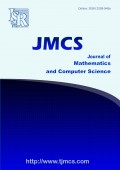A new perturbed smooth penalty function for inequality constrained optimization
Volume 23, Issue 1, pp 36--48
http://dx.doi.org/10.22436/jmcs.023.01.04
Publication Date: October 02, 2020
Submission Date: December 05, 2019
Revision Date: January 24, 2020
Accteptance Date: April 22, 2020
-
1233
Downloads
-
2799
Views
Authors
Touna Yang
- Department of Applied Mathematics, Northwestern Polytechnical University, Xi'an 710072, China.
Nguyen Thanh Binh
- Department of Education and Training Yen Bai, Yen Bai city 32000, Vietnam.
Truong Minh Chinh
- Viet Tri University of Industry, Viet Tri city 35000, Vietnam.
Le Huu Tung
- Viet Tri University of Industry, Viet Tri city 35000, Vietnam.
Duong Thi Hoa
- Yen Bai Teacher's Training College, Yen Bai city 32000, Vietnam.
Abstract
In this paper, we first propose a new smoothing approach to the nonsmooth penalty function for constrained optimization problems, and then show that an approximate optimal solution of the original problem can be obtained by solving an optimal solution of the smoothed optimization problem. Based on the perturbed smooth exact penalty function, we develop an algorithm respectively to finding an approximate optimal solution of the original constrained optimization problem and prove the convergence of the proposed algorithm. The effectiveness of the smoothed penalty function is illustrated through three examples, which show that the algorithm seems efficient.
Share and Cite
ISRP Style
Touna Yang, Nguyen Thanh Binh, Truong Minh Chinh, Le Huu Tung, Duong Thi Hoa, A new perturbed smooth penalty function for inequality constrained optimization, Journal of Mathematics and Computer Science, 23 (2021), no. 1, 36--48
AMA Style
Yang Touna, Binh Nguyen Thanh, Chinh Truong Minh, Tung Le Huu, Hoa Duong Thi, A new perturbed smooth penalty function for inequality constrained optimization. J Math Comput SCI-JM. (2021); 23(1):36--48
Chicago/Turabian Style
Yang, Touna, Binh, Nguyen Thanh, Chinh, Truong Minh, Tung, Le Huu, Hoa, Duong Thi. "A new perturbed smooth penalty function for inequality constrained optimization." Journal of Mathematics and Computer Science, 23, no. 1 (2021): 36--48
Keywords
- Exact penalty function
- inequality constrained optimization
- smoothing method
- optimal solution
MSC
References
-
[1]
I. Ahmad, A. Ayswal, J. Banerjee, On interval-valued optimization problems with generalized invex functions, J. Inequal. Appl., 2013 (2013), 14 pages
-
[2]
M. S. Bazaraa, J. J. Goode, Sufficient conditions for a globally exact penalty function without convexity, Math. Programming Stud., 19 (1982), 1--15
-
[3]
N. T. Binh, Smoothing approximation to $l_1$ exact penalty function for constrained optimization problems, J. Appl. Math. Inform., 33 (2015), 387--399
-
[4]
N. T. Binh, Smoothed lower order penalty function for constrained optimization problems, IAENG Int. J. Appl. Math., 46 (2016), 76--81
-
[5]
N. T. Binh, Y. Q. Bai, X. Yan, T. Yang, Perturbed smoothing approach to the lower order exact penalty functions for nonlinear inequality constrained optimization, Tamkang J. Math., 50 (2019), 37--60
-
[6]
C. H. Chen, O. L. Mangasarian, Smoothing methods for convex inequalities and linear complementarity problems, Math. Programming, 71 (1995), 51--69
-
[7]
G. Di Pillo, L. Grippo, An exact penalty function method with global convergence properties for nonlinear programming problems, Math. Programming, 36 (1986), 1--18
-
[8]
J. B. Etoa Etoa, Solving quadratic convex bilevel programming problems using a smoothing method, Appl. Math. Comput., 217 (2011), 6680--6690
-
[9]
S. P. Han, O. L. Mangasrian, Exact penalty function in nonlinear programming, Math. Programming, 17 (1979), 251--269
-
[10]
J. B. Lasserre, A globally convergent algorithm for exact penalty functions, European J. Oper. Res., 7 (1981), 389--395
-
[11]
H. Li, L. Zhang, Y.-C. Jiao, An interactive approach based on a discrete differential evolution algorithm for a class of integer bilevel programming problems, Internat. J. Systems Sci., 47 (2016), 2330--2341
-
[12]
Z. Q. Meng, C. Y. Dang, X. Q. Yang, On the smoothing of the square-root exact penalty function for inequality constrained optimization, Comput. Optim. Appl., 35 (2006), 375--398
-
[13]
J. Nocedal, S. J. Wright, Numerical Optimization, Springer-Verlag, New York (1999)
-
[14]
M. C. Pinar, S. A. Zenios, On smoothing exact penalty function for convex constrained optimization, SIAM J. Optim., 4 (1994), 486--511
-
[15]
L. Q. Qi, X. J. Tong, Y. J. Wang, Computing power system parameters to maximize the small signal stability margin based on min-max models, Optim. Eng., 10 (2009), 465--476
-
[16]
E. Rosenberg, Exact penalty functions and stability in locally Lipschitz programming, Math. Programming, 30 (1984), 340--356
-
[17]
M. Ruiz Galán, Elementary convex techniques for equilibrium, minimax and variational problems, Optim. Lett., 12 (2018), 137--154
-
[18]
Y. H. Sun, L. S. Wang, Optimality conditions and duality in nondifferentiable interval-valued programming, J. Ind. Manag. Optim., 9 (2013), 131--142
-
[19]
C. W. Wang, Y. J. Wang, A superlinearly convergent projection method for constrained systems of nonlinear equations, J. Glob. Optim., 44 (2009), 283--296
-
[20]
Z. Y. Wu, F. S. Bai, X. Q. Yang, L. S. Zhang, An exact lower order penalty function and its smoothing in nonlinear programming, Optimization, 53 (2004), 51--68
-
[21]
Z. Y. Wu, H. W. J. Lee, F. S. Bai, L. S. Zhang, Quadratic smoothing approximation to $l_1$ exact penalty function in global optimization, J. Ind. Manag. Optim., 1 (2005), 533--547
-
[22]
T. Yang, N. T. Binh, T. M. Thang, D. T. Hoa, A new smoothing nonlinear penalty function for constrained optimization, Math. Comput. Appl., 22 (2017), 14 pages
-
[23]
C. J. Yu, K. L. Teo, L. S. Zhang, Y. Q. Bai, A new exact penalty function method for continuous inequality constrained optimization problems, J. Ind. Manag. Optim., 6 (2010), 895--910
-
[24]
W. I. Zangwill, Non-linear programming via penalty functions, Management Sci., 13 (1967), 344--358
-
[25]
S. A. Zenios, M. C. Pinar, R. S. Dembo, A smooth penalty function algorithm for network-structured problems, Eur. J. Oper. Res., 83 (1995), 220--236

